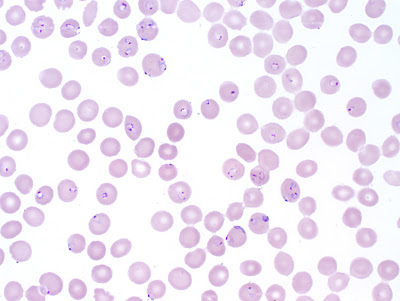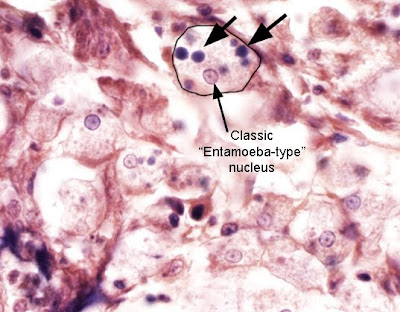Answer: Anisakid larvae
Thanks to everyone who wrote in with the answer to this case. You all recognized this as one of the anasakid nematode (roundworm) larvae.
Anisakiasis is a zoonotic disease, with marine mammals (e.g. dolphins, seals) serving as the definitive hosts. Humans become accidental hosts after ingesting raw or undercooked seafood containing anisakid larvae. The larvae can't complete their life cycle in humans, but may attempt to embed in human gastric or intestinal mucosa, resulting in intense pain, and rarely, perforation. A chronic granulomatous response can also develop, mimicking inflammatory bowel disease. Alternatively, larvae may be "coughed up" or passed symptomatically in stool.
Luke Roberts reminds us that some individuals may experience gastroallergic reaction to anisakid antigens (in either alive or dead worms), resulting in urticaria (hives), erythema (redness), angioedema (swelling beneath the skin), bronchospasm (constriction of the airways), and even anaphylaxis (severe whole body reaction).
Human anisakiasis is most commonly caused by
Anisakis simplex and
Pseudoterranova decipiens (previously
Phocanema decipiens).
Diagnosis can be made by identification of characteristic features of 2-cm anisakid larvae, including a posterior mucron or "spine" (when present) and 3 poorly formed anterior lips with a small boring tooth. Speciation is performed by examining the size, presence, and position of the intestinal cecum. B.A.M. comments that "A genus-level ID is not possible from these images, but there appears to be a hint of an anteriorly-directed intestinal cecum, which would support
Pseudoterranova."

Anisakiasis is most common in places where people eat undercooked/uncooked saltwater fish or squid. Commonly infected fish include cod (Atlantic or Pacific), Pacific halibut, mackerel, salmon, and red snapper. Some studies have reported over 90% of examined fish to be infected. Fresh water fish may also be infected. The United States FDA and fishmongers/grocers try to mitigate the risk of anisakiasis by removing the worms prior to consumption. However, it's still easy to find these larvae. I can typically find at least 1 in a bag of 7 frozen cod fillets!
Fortunately, freezing kills the worm, and greatly decreases the risk of acute disease. However, as anonymous states "Freezing should render non-infectious, but I'll pass just the same."
According to the
CDC, "adequately cooking fish (60° C) or freezing (-20° C for seven days or -35° C for 15 hours) before ingestion will kill anisakid helminths" and thus eliminate the risk for acute anisakisis.

















